By Jeffrey A. Rendall, Photos by Jeffrey A. Rendall
RINGOES, NJ – Dreams are mysterious – we all have them, and no one really knows where they come from or why we might dream about a particular subject or person. We can’t shut them off and they rarely come true – but for one golf loving accountant from New Jersey, he not only dreamed of building a first class golf-only country club, he actually went ahead and lived it.
We’re speaking of The Ridge at Back Brook located in Ringoes, New Jersey – about a half hour drive from Princeton in some of the most beautiful rolling countryside you’re ever going to see. The Tom Fazio-designed Ridge is the ultimate result of a ‘dream’ of its owner and creator, Joel Moore, and with the club, Moore provides a vivid glimpse into what he thinks about a lot – even in his sleep.
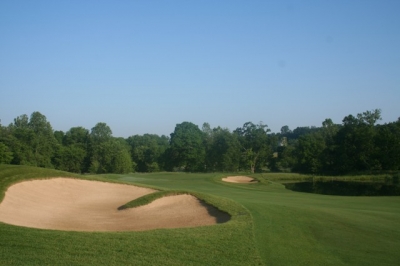 |
| Tom Fazio beautifully shaped the golf holes into the environment at The Ridge. Here, looking from the fairway of the par four 1st hole. |
Lots of people talk about ‘realizing’ dreams, but for Moore, his story’s actually true.
“One morning, I think it was a Sunday, I woke up my wife and told her I was going to build a golf-only, private, exclusive golf club and have Tom Fazio design it,” Moore remembered. “And she kind of looked at me in bewilderment and went right back to sleep – she probably thought I was hallucinating.”
Maybe it was a dream or merely a ‘vision,’ but that morning’s revelation set Moore in motion towards building his golf club. Moore had been part of another new country club in the Princeton area in the early nineties, serving as its president for the club’s first eight years. But then the club’s residential community grew up around it to the point where it ‘matured’ into the private gated community that it was intended to be, and Moore felt it was only appropriate for non-residents like himself to move on.
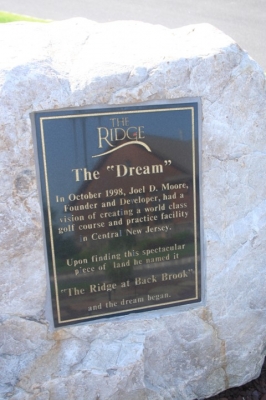 |
| A plaque in front of the clubhouse is dedicated to the 'dream' that eventually came true in the form of The Ridge at Back Brook. |
As a result, he joined another new club that had opened in nearby Pennsylvania – and his other friends from the Princeton area club also spread out to all different clubs as well. The results of their divergent locales and their dissatisfaction with the level of attention that golf was receiving at these new golf homes inevitably led to Moore’s ‘dream.’
It seems the time was ripe to build a true golf-only club in central New Jersey, a place where purists could go to concentrate on golf alone, with no pool, no tennis, and no residential component to distract from the main focus – and to be designed to the highest standards possible for the people in the area.
Never one to sit on a good idea, Moore immediately started searching for his new club’s most important element – land. “I just started looking for land, started hiking. I contacted all the large landowners in the region and poured over their inventory lists. Unfortunately, most of the available parcels were just flat pieces of farm land with no trees and no interesting rocks or streams or ponds or anything. I wasn’t getting too far, and my enthusiasm was starting to wane a little bit.”
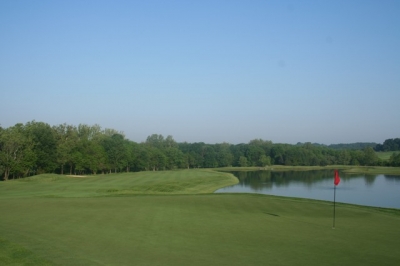 |
| From behind the green of the (442-yard) par four 3rd hole, you'll see water challenges you from tee to green. |
As would be true for any dream-made-real story, one event changed everything for Moore. He was on his way home from his accounting office one afternoon and looked at one of his inventory lists – and spotted a piece of property that he could check out taking the back way home. Upon visiting this new parcel, he was shocked at what he saw: elevation changes, streams, rock outcroppings and mature trees. Was this it?
“I started hiking it and came across what we now call the ‘Ridge,’ which is an 80-foot vertical rock wall, and I got very excited and had trouble hiking out because it was getting dark,” Moore recalls. “I thought I’d come back the next morning, hoping to find the same spot. I was really stunned to find this land, but then the thought occurred to me that I wasn’t even sure I was on the right property, since of course there weren’t any markers.”
He did return the following morning and hiked the land again and even saw more of it because he had plenty of daylight – and his further investigation revealed that he hadn’t been ‘dreaming’ the night before.
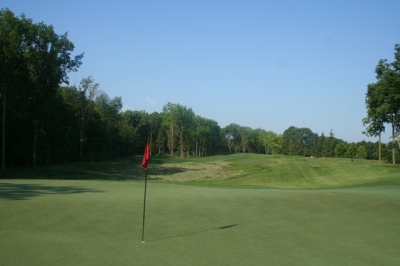 |
| The par three 17th hole is the last of a great set of Fazio-designed par threes. |
Having found what he considered to be the ideal piece of real estate, now came the next crucial item in his ‘dream’ checklist – contacting Tom Fazio about making his golf aspiration come true. This was late in 1998, and golf’s 90’s construction boom was just reaching its apex – so there certainly was no guarantee that Fazio would even be interested in the project, since he was very much able to pick and choose where and what golf courses he wanted to design.
Moore said the Fazio folks were very polite when he made the initial phone call, not knowing who he was or if he actually had a serviceable piece of land – so he obtained a topographical map of the property and sent it to them, with a promise from Fazio’s staff to look it over and get back to him with their impressions.
A couple days later Moore got a call from Fazio’s business manager (at the time), Beau Welling, who said there would be a team from Fazio’s firm flying up to take a look at the property the next day. Moore met them at the airport and the group then spent the better part of two days walking the property, through all the briers and sticker bushes and various other hazards that an unimproved piece of land represents – but they also started to grasp the property’s potential for a special kind of golf course.
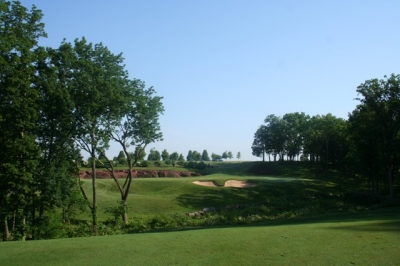 |
| There's a mild carry to the green of the par five 5th hole, requiring you to strategically decide where to lay-up your second shot. |
Moore remembered that the Fazio group left very enthused about the project, particularly the notion of it being devoted to a golf-only club with no real estate component – which certainly opened up the possibilities for design. Again, they said they would be in touch after discussing it with Tom himself.
The property once-over took place around the middle of November in 1998, and Moore thinks a couple months passed before it was decided that they’d all get together at the PGA show in Orlando to meet with Fazio face-to-face for the first time. All along, Moore had been insistent about Fazio’s presence in the project, but the architect was about to find out just how crucial his participation would be to its existence.
Moore says their first meeting was cordial, but Fazio was curious as to why Moore insisted that it be him -- and him only -- to design the golf course. Moore recalled that Fazio’s first question was ‘if I decide not to do it, then who is your second choice to design the golf course?’ and Moore answered, ‘Tom, if you decide, for whatever reason not to do it, or we can’t come to an agreement, I’m not building the golf course. It’s going to be a Tom Fazio course, or there’s not going to be a Ridge at Back Brook.’
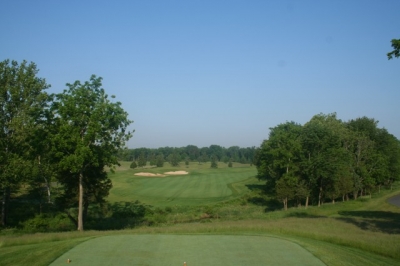 |
| The Fazio 'wow' factor is on full display off the tee of the par four 10th hole. |
Fazio says he was initially taken aback a bit by Moore’s single-minded determination, wondering, why did it have to be me? “My first reaction was, is this guy for real? I mean, there’re a lot of other people out there that design golf courses. He happened to be a committed kind of a guy, and it’s obviously a special kind of thing – but it also puts a lot of responsibility on you to produce.”
Moore explained that he’d been to a great many of Fazio’s courses and laid out the elements that he liked about them – and also the fact that there would be no residential component and that Fazio would have pretty much free reign on the property to create the best golf course that the land could produce, and a comfort level was reached and the deal was sealed.
Fazio was impressed by Moore’s (and his wife Pam’s) commitment to the project, and also the fact that Moore had a business background that would bring some realistic expectations. “I liked the fact that Joel was an accountant, because numbers are very important. Dreaming is one thing, and that’s good, but being a numbers person is another factor. I get the same reaction from a lot of people that fall in love with their own land, and it’s the last best piece – it’s the only one left.”
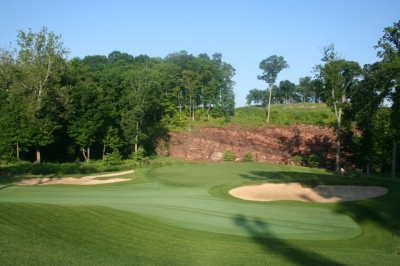 |
| The 80-foot red rock wall behind the par three 8th hole provides the answer to why Joel Moore's club is named 'The Ridge.' |
“But Joel had a great piece of land and would be able to work with the numbers – that was an important piece of the puzzle for me,” Fazio said.
Once the parties came to terms, construction began (in the fall of 1999) with clearing of the land and starting the permitting process with the local government agencies. Because all the parties were determined to design the best golf course that they possibly could, it wasn’t easy to settle on a routing plan.
“The Fazio people kept reminding me, and I kept reminding the authorities (and his potential club members), that what may be on paper may not turn out to be what we end up building,” Moore said. “Because we were set on building the best eighteen holes we could build – and we didn’t know how it would work out until we were on the ground with bulldozers, with the land cleared, moving dirt, etc.”
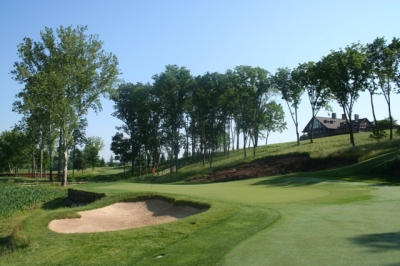 |
| The par four 9th hole concludes within site of the clubhouse, and incorporates all the elements of The Ridge - red rock, the stream and wetlands. |
Because of this commitment to flexibility and quality, Moore says it took 24-25 different routing plans to agree on the one they ultimately ended up building. The land’s natural gifts caused them to shift focus at times, including the discovery of the property’s most distinctive feature, red rock.
According to Fazio, there are usually little surprises on every piece of land, and the red rock at The Ridge was no different. “When you’re talking about 300 acres of land, you don’t do test borings every quadrant like you would for a high rise building that only occupies a couple acres – so you never know what you’re going to get in a lot of cases, and you just work with it wherever you go.”
He continues, “At the Ridge, we knew there was rock under the site, but we didn’t know the color, texture, etc., and some rock is just not very attractive – it fragments, it’s sharp, it doesn’t have good color. So getting to that red rock on the seventh hole (par five) especially, and so many other areas was a great thing to incorporate into the overall environment of the golf course.”
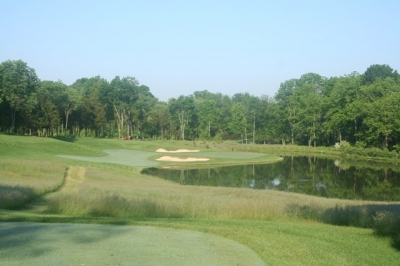 |
| The green of the par three 12th hole juts menacingly out into a pond. |
Moore thinks the red rock makes it almost feel like you’re in Arizona, particularly the 80-foot high ‘ridge’ that serves as the backdrop to the par three eighth hole. The rock also is prominently seen on other parts of the golf course (in addition to the seventh and eighth holes), such as the par five fifth hole, the par four ninth and the par five finishing hole.
The club opened, red rock and all, in 2002.
While it’s true that The Ridge has all the scenic qualities, it’s also proven to be a great golf course to play, due to its fantastic conditioning, and also because of what Moore calls the ‘wow’ factor. “One of the things I love about Fazio designs is, when you step onto one of his tee boxes, his goal is to always make it very dramatic, or as he likes to describe it, the ‘wow’ factor.”
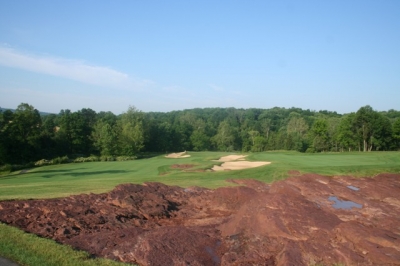 |
| The Ridge's red rock isn't just for show on the par five 7th hole - it comes into play if you're not careful. |
“Fazio starts his hole designs from the tee box going forward, where a lot of architects start their significant shaping, etc. from the landing area into the green,” Moore added.
Another aspect that will ‘wow’ you at The Ridge and all of Fazio’s courses is the width of the playing areas, with the architect’s generous usage of the property’s 300 acres to golfers’ advantage – so if you should hit one a little off-line, you’ll at least have a shot at playing it.
Fazio said the fact that The Ridge was a private club with limited membership didn’t factor into his thinking on what kind of course to design: “For me, it’s how do you create the best with the land that you have to work with – how do you make it spectacular and sensational for the best players in the world, and how do you make it enjoyable and fun for beginners and high-handicap, middle-level players, older people, etc. All levels of players are extremely important in designing every course.”
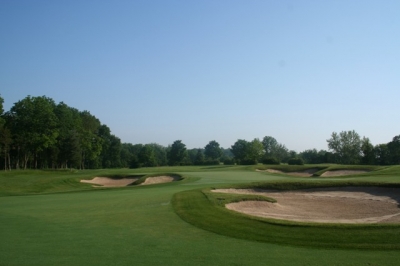 |
| Bunkers guard the short approach and the green of the par five 14th hole. |
Another way Fazio accomplishes playability at The Ridge is the multiple sets of tee boxes he’s designed. “With this much land, on many of our holes, we have six or seven tee boxes, with different angles and different elevations – so there’s a lot of variety,” Moore said.
“And seeing as it’s a private club, and our members are playing the course on a regular basis, one of the things that makes us stand out so much is that we have so many tee boxes – so our members can get a different feel, a different length every day they play the golf course if we fix it up enough,” Moore elaborated.
Fixing it up is assigned partly to the club’s superintendent (Tom Vosters), who does nothing short of a spectacular job keeping the golf course in shape – as good as we’ve ever seen. Particularly impressive were The Ridge’s greens, which Moore says are purposely kept up to tournament standards, every day.
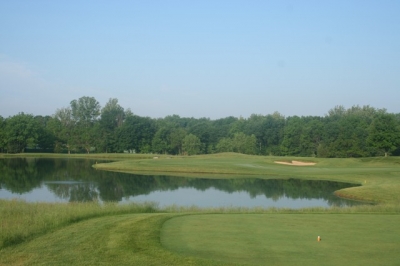 |
| The par three 2nd hole looks intimidating from the tee, but the landing area is quite generous for a 195-yard hole. |
“I think from the moment we opened the course, our greens have been as good or better than any others in the metropolitan area,” Moore said proudly. “Everyone who plays the course walks off saying these are the best greens they’ve ever played, I’ve heard people say our greens are equal to or better than the ones you see on TV.”
As far as favorite holes, Moore says he’s partial to the par five seventh hole, which includes a split fairway and red rock outcroppings influencing play, as well as the ‘short’ par four ninth hole, which plays along Back Brook, the stream that’s part of the club’s name. It’s also got rock outcroppings along the right side and behind the green.
On the back side, Moore points to the par three twelfth as a hole that everyone enjoys – with its green jutting out into a pond – simply put, a beautiful golf hole. And no course of this stature would be complete without a memorable finishing hole – and the par five eighteenth fits the bill nicely, with its risk-reward qualities and dramatic red rock backdrop and the clubhouse staring down from above.
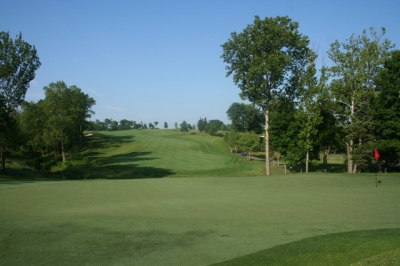 |
| From behind the green of the risk-reward par five finishing hole - a hole where Moore says there are plenty of birdies and bogeys being made. |
The golf course, along with the service from the staff is all part of what Moore calls the ‘Ridge Experience.’ “The ‘Ridge Experience’ starts when you pull up onto our property, with 300-acres spread out before you. The outside world cannot see in, but our members can see out to the beautiful views and vistas. We want them to be able to shut out the outside world if they want to, take advantage of a world class practice facility, play a great championship golf course that’s in perfect tournament condition all the time, and then come back and do it again the next time.”
To that end, Moore says they often receive notes from guests of the club who rave about the ‘experience’ and their treatment at the hands of the staff as well as accolades for the golf course.
The Ridge is truly that special – and the club’s members are fortunate to be part of it.
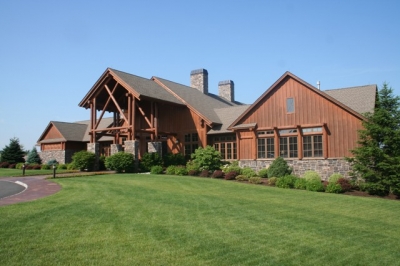 |
| The Ridge's impressive clubhouse looks like a mountain lodge. |
Fazio says he’s often asked to name his favorite golf course that he’s designed, and while it’s impossible for him to choose only one – he could see putting the names of sixty golf courses in a hat, and when one was drawn out, he’d be able to say that was the one.
“If that were the case, and I ended up picking only one at random as the best course I’ve ever done, I’d honestly be able to say it’s true in the Ridge’s case -- because The Ridge is that kind of a special place. You’re not going to find a golf course anywhere any better than the Ridge,” Fazio concluded.
It just goes to prove that in the end, some ‘dreams’ really do come true.
Details:
The Ridge at Back Brook
211 Wertsville Road
Ringoes, NJ 08551
Phone: (609) 466-7702
FAX: (609) 466-7727
Website: www.TheRidgeGC.com
Owner and ‘dreamer’: Joel Moore
Course designer: Tom Fazio
Superintendent: Tom Vosters, GCSAA
Tees/Yardage/Slope/Rating
Gold 7153 143/74.8
Blue 6686 137/72.7
Silver 6068 133/70.2 142/76.8 (L)
Green 5180 131/71.0 (L)
Membership Information:
If you’re interested in finding out more about the Ridge at Back Brook, call the phone number above and ask for the Membership Director.
| Related Links | Comments on this article? | |
|
Maryland National Golf Club Hollow Creek Golf Club Rocky Gap Resort PB Dye Golf Club in Ijamsville Whiskey Creek Golf Club |
E-mail Jeff Rendall, Editor: jrendall@golftheunitedstates.com |












